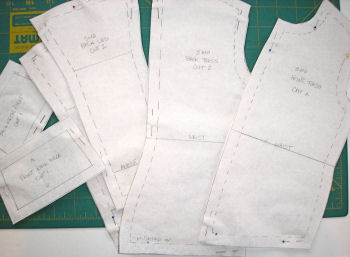After studying measurement charts until my eyes about popped out of my head, I finally took the plunge and drafted my first bodice using
Aldrich's method. After working for many years in the childrenswear business, I have never actually drafted my own blocks. There was never a need - I just used whatever the company had. I drafted the flat infant blocks and immediately it didn't look right. I have been a bit confused by her use of
flat, jersey, and
woven bodices. Later in the book, she has a
classic bodice. I picked the flat bodice block because it was in the front of the book.
The problem I encountered with the flat block is it looked too long in the length, especially the scye depth. This is partly where art meets technical design. Most infant bodices are drafted intentionally above the waist. Proportionally it just looks better. Until about age 3 a child's waist falls half-way on the body. Interior designers, architects, fashion, etc., use the
golden mean or 1 to 3 proportion. This is something that is almost never mentioned in any pattern drafting instructions for childrenswear. The instructions always have you draft the back neck to the true waist I am sure they neglect to mention this because every designer decides where exactly their
waist line will fall. Generally speaking this waistline can fall anywhere from 1-2" above the natural waist. This practice is used on nearly all childrenswear up to age 16, especially on any infant casual clothing and girl's dresses. Casual boys wear mimics the proportions of adults as they get older. Confusing, huh!
When drafting the basic blocks it is important to decide on what kind of product you are going to make. Who knew so many decisions have to made so far ahead in product development?!
I don't really like Aldrich's flat blocks. Even with adjusting the waist line, the scye depth is too long, IMO. Instead, I flipped ahead and drafted her
classic block. The classic block is drafted to fit closer to the body and is used in formal wear. To me this is a better place to start. The armhole and neck shapes look better. The
flat block can later be extrapolated from the
classic. If I understand Aldrich correctly, the flat block is a method used in the children's business where the front and back bodice pieces are essentially the same shape, except for the necklines. By starting with the classic block, you can then add your own additional ease and modify the neck and armhole shaping that makes sense to you.
My next project is to draft the classic block without ease and make my own children's dress form. I read about a similiar proceedure at
Vintage Sewing. With the cost of dress forms, I thought this might be a more economical solution and I would have a form with my measurements. I'll let you know how it turns out.



